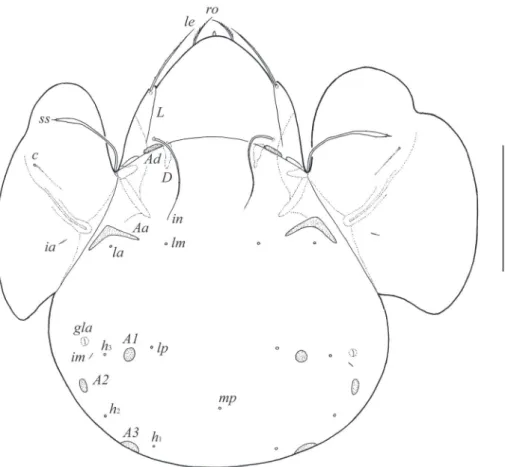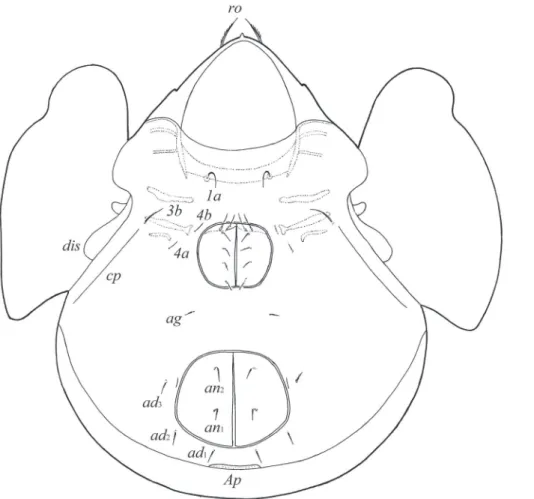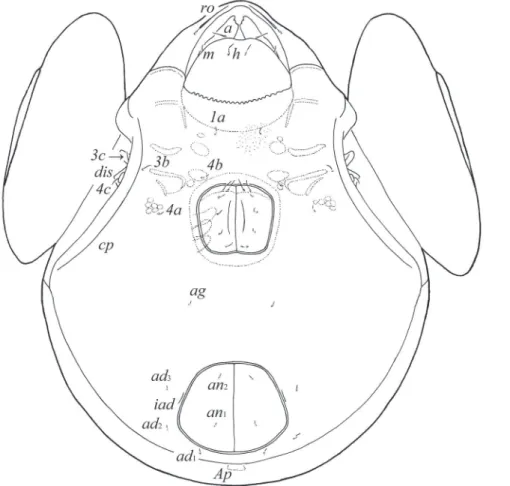The oribatid mite subgenus
Galumna
(
Galumna
)
(Acari, Oribatida, Galumnidae) in the Philippines
Sergey G. Ermilov1, Leonila Corpuz-Raros2, Andrei V. Tolstikov1
1 Tyumen State University, Tyumen, Russia 2 Crop Protection Cluster, College of Agriculture and Museum of Natural History, University of the Philippines Los Baños, Los Baños, Philippines
Corresponding author:Sergey G. Ermilov (ermilovacari@yandex.ru)
Academic editor:V. Pesic | Received 14 September 2014 | Accepted 13 October 2014 | Published 4 November 2014
http://zoobank.org/9FEDDB41-5661-4EF8-BFAD-25247359CBBB
Citation: Ermilov SG, Corpuz-Raros L, Tolstikov AV (2014) he oribatid mite subgenus Galumna (Galumna) (Acari, Oribatida, Galumnidae) in the Philippines. ZooKeys 452: 1–13. doi: 10.3897/zookeys.452.8212
Abstract
Five species of the subgenus Galumna (Galumna) (Acari, Oribatida, Galumnidae) are registered in the Philippine oribatid mite fauna. A new species, G. (G.) makilingensis sp. n., is described; it is most similar morphologically to G. (G.) tokyoensis Aoki, 1966, but difers from the latter by the morphology of porose areas Aa and Ap, rostral setae, and length of interlamellar setae. hree species, G. (G.) crenata Deb & Raychaudhuri, 1975, G. (G.) cf. exigua Sellnick, 1925 and G. (G.) khoii Mahunka, 1989, are recorded in the Philippines for the irst time. he species G. (G.) crenata is redescribed. An identiication key to the Philippine species of Galumna (Galumna) is given.
Keywords
Oribatida, Galumnidae, Galumna (Galumna), new species, supplementary description, key, Philippines
Introduction
Galumna (Galumna) is the largest subgenus of Galumna Heyden, 1826, comprising 161 species, which have a cosmopolitan distribution (based on data by Subías 2004, updated 2014). In the course of taxonomic identiication of oribatid mites from the Philippines, we found ive species of this subgenus: one species is represented as a new to science and other four are already known ones (see Checklist section below). At pre-sent, only G. (G.) labellifera Hammer, 1958 was reported from the Philippines (see Corpuz-Raros 1979; Corpuz-Raros and Gruèzo 2011).
http://zookeys.pensoft.net
Copyright Sergey G. Ermilov et al. This is an open access article distributed under the terms of the Creative Commons Attribution License (CC BY 4.0), which permits unrestricted use, distribution, and reproduction in any medium, provided the original author and source are credited.
Material and methods
he species of Galumna (Galumna) were found in 11 sites:
L-1 Philippines, Mindanao Island, Nasipit Lumber Company, Tungao, Agusan del Norte, in leaf litter, 28.V.1977, collected by J.M. Sotto and R.C. Garcia. L-3 Philippines, Luzon Island, Animal Science pasture, University of the
Philippines Los Baños campus, College, Laguna, in litter from pasture, 28.VI.1975, collected by J.M. Sotto and R.C. Garcia.
L-5 Philippines, Luzon Island, Mt. Makiling, Makiling Botanic Gardens, Los Baños, Laguna, in topsoil from plantation of Moluccan Sau (Albizia falcataria), 8.VI.1975, collected by J.M. Sotto and R.C. Garcia.
L-16 Philippines, Luzon Island, Mt. Makiling, Makiling Botanic Gardens, Los Baños, Laguna, in litter from undistrurbed secondary forest, 1.VI.1975, collected by J.M. Sotto and R.C. Garcia.
L-20 Philippines, Luzon Island, Mt. Makiling, Makiling Botanic Gardens, Los Baños, Laguna, in litter from plantation of molave (Vitex parvilora), 19.VII.1975, collected by J.M. Sotto and R.C. Garcia.
L-21 Philippines, Luzon Island, Maddela, Quirino, in bamboo leaf litter, 11.XI.1975, collected by P.S. Raros.
L-23 Philippines, Panay Island, Panay State Polytechnic College campus, Mambusao, Capiz, in grass litter, 12.X.1990, collected by A.M. Almeroda.
L-34 Philippines, Luzon Island, Tagga, Tuguegarao, Cagayan, in forest litter, 14.XI.1975, collected by P.S. Raros.
L-40 Philippines, Luzon Island, Animal Science pasture, University of the Philippines Los Baños campus, College, Laguna, in litter at base cogon (Imperata cylindrica), 16.IX.1975, collected by J.M. Sotto and R.C. Garcia.
L-43 Philippines, Mindanao Island, Nasipit Lumber Company, Tagpange, Tungao, Agusan del Norte, in litter from Albizia falcataria–Ipomoea sp., fern vegetation, 28.IV.1975, collected by R.S. Raros.
Specimens were mounted in lactic acid on temporary cavity slides for measure-ment and illustration. he body length was measured in lateral view, from the tip of the rostrum to the posterior edge of the ventral plate. he notogastral width refers to the maximum width in dorsal aspect. Lengths of body setae were measured in lateral aspect. All body measurements are presented in micrometers. Formulae for leg setation are given in parentheses according to the sequence trochanter–femur–genu–tibia–tar-sus (famulus included). Formulae for leg solenidia are given in square brackets accord-ing to the sequence genu–tibia–tarsus. General terminology used in this paper follows that of Grandjean (summarized by Norton and Behan-Pelletier 2009). Drawings were made with the drawing tube using the Carl Zeiss transmission light microscope “Axi-oskop-2 Plus” at Tyumen State University, Russia.
Checklist of registeredGalumna (Galumna) species
Galumna (Galumna) crenata Deb & Raychaudhuri, 1975. Distribution: India. Locality: L-1. First record in the Philippines.
Galumna (Galumna) cf. exigua Sellnick, 1925. Distribution: Sumatra. Localities: L-1, L-20, L-21, L-23, L-43, L-45. First record in the Philippines.
Galumna (Galumna) labellifera Hammer, 1958. Distribution: Pantropics and Subtropics. Localities: L-1, L-3, L-5, L-21, L-23, L-34.
Galumna (Galumna) khoii Mahunka, 19891. Distribution: Vietnam. Localities: L-3,
L-16, L-23, L-40. First record in the Philippines.
Galumna (Galumna) makilingensis sp. n.: Locality: L-45
Results
Description of Galumna (Galumna) makilingensis sp. n.
http://zoobank.org/4BC74FB7-37C4-4670-8C6D-0BB8BA67C262 Figs 1–4
Diagnosis. With generic characters of Galumna as summarized by Ermilov et al. (2013). Body size: 647–680 × 498–547. Rostrum pointed. Rostral setae of medium size, ciliate. Lamellar and interlamellar setae long, slightly barbed. Bothridial setae spindle-form. Lamellar lines very strong, divergent in distal parts to sublamellar lines. Anterior notogastral margin developed. Four pairs of porose areas present; Aa
boomerang-like, other rounded or oval. Median pore present. Postanal porose area long, elongated.
Description. Measurements. Body length: 647 (holotype, female), 680 (one para-type, female); notogaster width: 498 (holotype), 547 (one paratype).
1 It is possible that Galumna (Galumna) khoii Mahunka, 1989 is a junior synonym of G. (G.) lanceata
Integument. Body color brown. Body surface smooth.
Prodorsum. Rostrum pointed. Rostral setae (ro, 49–57) setiform, ciliate unilater-ally. Lamellar (le, 118–127) and interlamellar (in, 172–184) setae setiform, slightly barbed. Bothridial setae (ss, 135–147) spindle-form, with long stalk and short, slightly barbed head. Exobothridial setae and their alveoli absent. Porose areas Ad oval, trans-versally oriented (24–32 × 6–10). Sublamellar lines (S) distinct, thin, curving back-wards. Lamellar lines (L) very strong, parallel in basal parts and divergent in distal parts to sublamellar lines.
Notogaster. Anterior notogastral margin developed. Dorsophragmata (D) of me-dium size, longitudinally elongated. Notogastral setae represented by 10 pairs of al-veoli. Four pairs of porose areas with distinct borders: Aa boomerang-like (90–102 × 8–16), other porose areas rounded or oval; A1 (20–24 × 12–16 or diameter 16–20), A2 (24–32 × 12–16 or diameter 16–20) and A3 (24–45 × 20–24). Alveoli la inserted posteriorly to Aa. Lyriissures im and opisthonotal gland openings (gla) located later-ally to A1. Median pore (mp) present, located little posterior to virtual line connecting porose areas A2.
Gnathosoma. Morphology of subcapitulum, palps and chelicerae generally typi-cal for species of the subgenus Galumna (Galumna) (for example, Engelbrecht 1969; Ermilov and Anichkin 2011; Ermilov et al. 2011). Subcapitulum longer than wide (184 × 155). Subcapitular setae simple, slightly barbed: a (32–36) longer than m and h (both 24–28). Two pairs of adoral setae (20) setiform, barbed. Palps (135–139) with setation 0–2–1–3–9(+ω). Solenidion straight, thickened, blunt-ended, attached to eu-pathidium. Chelicerae (229) with two setiform, barbed setae; cha (57) longer than chb (32). Trägårdh’s organ distinct, tapered.
Epimeral and lateral podosomal regions. Apodemes (1, 2, sejugal, 3) well visible. Four pairs of setiform, slightly barbed epimeral setae present; 1a and 3b (41–49) long-er than 4a and 4b (24–32). Pedotecta II rectangular, rounded anteriorly in ventral view. Discidia (dis) rounded distally. Circumpedal carinae (cp) of medium length, directed to 3b.
Anogenital region. Six pairs of genital (g1–g6, 20–24), one pair of aggenital (ag, 20–24), two pairs of anal (an1, an2, 28–32) and three pairs of adanal (ad1–ad3, 28–32) setae setiform, slightly barbed. Anal and adanal setae slightly thicker than genital and
aggenital setae. Anterior edge of genital plates with two setae. Adanal setae ad3 inserted laterally to adanal lyriissures iad. Postanal porose area (Ap) long, elongated, transver-sally oriented (61–77 × 8–12).
Legs. Morphology of leg segments, setae and solenidia generally typical for species of the subgenus Galumna (Galumna) (for example, Engelbrecht 1969; Ermilov and Anichkin 2011; Ermilov et al. 2011; Bayartogtokh and Akrami 2014). Formulae of leg setation and solenidia: I (1–4–3–4–20) [1–2–2], II (1–4–3–4–15) [1–1–2], III (1–2–1–3–15) [1–1–0], IV (1–2–2–3–12) [0–1–0]; homology of setae and solenidia indicated in Table 1.
Material examined. Holotype (female) and one paratype (female): L-45.
Type deposition. he holotype is deposited in the collection of the Zoological Institute of the Russian Academy of Sciences, St. Petersburg, Russia; one paratype (dissected) is deposited in the collection of the Tyumen State University Museum of Zoology, Tyumen, Russia.
Etymology. he speciic name “makilingensis” refers to the type locality, Mt. Mak-iling, the forest reservation of the University of the Philippines Los Baños.
Comparison. In having large body size, pointed rostrum, spindle-form bothrid-ial setae, long prodorsal setae, anterior notogastral margin, four pairs of notogastral porose areas, Galumna (Galumna) makilingensis sp. n. is most similar to Galumna (Galumna) tokyoensis Aoki, 1966 from the Palaearctic region (Aoki 1966). However, it clearly difers from the latter by the boomerang-like porose areas Aa and long, elon-gated postanal porose area (versus both oval in G. (G.) tokyoensis), ciliate rostral setae (versus smooth in G. (G.) tokyoensis) and interlamellar setae longer than lamellar setae (versus similar in length in G. (G.) tokyoensis).
Also, in having large body size, bothridial setae with dilated head, long prodorsal setae, anterior notogastral margin, four pairs of notogastral porose areas, Aa boomer-ang-like, Galumna (Galumna) makilingensis sp. n. is most similar to Galumna ( Galum-na) cuneata Aoki, 1961 from the Palaearctic region (Aoki 1961). However, it clearly difers from the latter by the pointed rostrum (versus rounded in G. (G.) cuneata), ciliate rostral setae (versus smooth in G. (G.) cuneata), interlamellar setae longer than lamellar setae (versus similar in length in G. (G.) cuneata) and spindle-form bothridial setae (versus clavate in G. (G.) cuneata).
Table 1.Leg setation and solenidia of Galumna (Galumna) makilingensis sp. n. (same data for G. (G.)
crenata Deb & Raychaudhuri, 1975).
Leg Trochanter Femur Genu Tibia Tarsus
I v’ d, (l), bv’’ (l), v’, σ (l), (v), φ1, φ2 (ft), (tc), (it), (p), (u), (a), s, (pv), v’, (pl), l’’, ε, ω1, ω2 II v’ d, (l), bv’’ (l), v’, σ (l), (v), φ (ft), (tc), (it), (p), (u), (a), s, (pv), ω1, ω2
III v’ d, ev’ l’, σ l’, (v), φ (ft), (tc), (it), (p), (u), (a), s, (pv)
IV v’ d, ev’ d, l’ l’, (v), φ ft’’, (tc), (p), (u), (a), s, (pv)
Prodorsum. Rostrum rounded. Rostral setae (24–32) setiform, smooth. Lamellar and interlamellar setae minute (both 6–8), thin, smooth. Bothridial setae (49–57) clavate, with long stalk and shorter, rounded and weakly barbed distally head. Exobothridial
setae and their alveoli absent. Porose areas Ad large, oval, transversally oriented (20–22 × 6–8). Lamellar and sublamellar lines distinct, thin, parallel, curving backwards.
Notogaster. Anterior notogastral margin developed, but sometimes poorly visible. Dorsophragmata of medium size, longitudinally elongated. Notogastral setae rep-resented by 10 pairs of alveoli. Four pairs of porose areas with distinct borders: Aa large, boot-shaped or weakly triangular, transversally oriented (32–36 × 12–16); A1, A2 (diameter of both 8–16) and A3 (diameter of 14–20) rounded. Alveoli la inserted posteriorly to Aa. Lyriissures im located between lm and lp. Opisthonotal gland open-ings located laterally to A1. Median pore present, located little anterior to virtual line connecting porose areas A3.
Gnathosoma. Morphology of subcapitulum, palps and chelicerae generally typi-cal for species of the subgenus Galumna (Galumna) (for example, Engelbrecht 1969; Ermilov and Anichkin 2011; Ermilov et al. 2011). Subcapitulum longer than wide (90–94 × 82–68). Subcapitular setae simple, smooth: a (14–16) longer and thicker
than m and h (both 6–8). Two pairs of adoral setae (8) setiform, slightly barbed. Palps (57) with setation 0–2–1–3–9(+ω). Solenidion straight, thickened, blunt-ended, at-tached to eupathidium. Chelicerae (106–110) with two setiform, barbed setae; cha (36) longer than chb (20). Trägårdh’s organ distinct, tapered.
Epimeral and lateral podosomal regions. Anterior tectum of epimere I with numer-ous rectangular teeth. Apodemes (1, 2, sejugal, 3) well visible. Six pairs of thin, smooth epimeral setae (8–12) present. Setae 4c inserted on tubercle. Pedotecta II rectangular, rounded anteriorly in ventral view. Discidia triangular. Circumpedal carinae long, di-rected to pedotecta I.
Anogenital region. Six pairs of genital setae (g1, g2, 8, g3–g6, 4–6), one pair of aggenital (ag, 6–8), two pairs of anal (an1, an2, 8) and three pairs of adanal (ad1–ad3, 8) setae thin, smooth. Anterior edge of genital plates with two setae. Adanal setae ad3 inserted laterally to adanal lyriissures iad. Postanal porose area oval, transversally oriented (12–20 × 6–8).
Legs. Morphology of leg segments, setae and solenidia generally typical for species of the subgenus Galumna (Galumna) (for example, Engelbrecht 1969; Ermilov and Anichkin 2011; Ermilov et al. 2011; Bayartogtokh and Akrami 2014). Formulae of leg setation and solenidia: I (1–4–3–4–20) [1–2–2], II (1–4–3–4–15) [1–1–2], III (1–2–1–3–15) [1–1–0], IV (1–2–2–3–12) [0–1–0]; homology of setae and solenidia indicated in Table 1.
Material examined. Four specimens (two females and two males): L-1.
Remarks.Galumna (Galumna) crenata distinctly difers from other species of the sugenus by the presence of dentate anterior tectum of epimere I. he available Philip-pine specimens of this species are morphologically and in general appearance similar to the Indian specimens (Deb and Raychaudhuri, 1975). hree main diferences are as follows:
1) Body longer (348–390 versus 319–325 in Indian specimens). We believe these diferences represent intraspeciic (perhaps geographical) variability.
2) Anterior notogastral margin is well visible (versus completely absent in Indian specimens); also, the text of other paper (Sarkar et al. 2007) on G. (G.) crenata assert that it is present.
3) Rostral, lamellar and interlamellar setae developed (versus absent in Indian specimens). We believe these diferences can be erroneous. he reason is that Deb and Raychaudhuri (1975) inadequately described this species and, probably, they over-looked these setae, because the rostral setae are usually strongly pressed to the prodor-sum surface and are often not visible in dorsal and ventral views, and the lamellar and interlamellar setae are minute, well visible only under high magniication.
Key to species of Galumna (Galumna) of the Philippines
size: 303–348 × 204–220 ...G. (G.) labellifera Hammer, 1958
(see also Aoki 1964, 1965, 1982). Distribution: Pantropics and Subtropics. – Bothridial head smooth; anterior notogastral margin not developed; body
size: 330 × 264 ... ...G. (G.) cf. exigua Sellnick, 1925. Distribution: Sumatra and Philippines.
Acknowledgements
We cordially thank Prof. Dr. Badamdorj Bayartogtokh (National University of Mongo-lia, Ulaanbaatar, Mongolia) and one anonymous reviewer for the valuable comments, Mr. Orlando Eusebio and Jeremy Naredo (Museum of Natural History, University of the Philippines Los Baños, College, Laguna, Philippines) for facilitating dispatchment of the specimens, together with other oribatids, to Russia.
References
Aoki J (1964) Some oribatid mites (Acarina) from Laysan Island. Pacif. Ins. 6(4): 649–664. Aoki J (1965) Oribatiden (Acarina) hailands. I. Nat. Life South. Asia 4: 129–193.
Aoki J (1982) New species of oribatid mites from the southern island of Japan. Bul. Ins. Env. Sci. Tech., Yokohama Nat. Univ. 8: 173–188.
Bayartogtokh B, Akrami MA (2014) he soil mite family Galumnidae of Iran (Acari: Oribatida). J. Nat. Hist. 48(15–16): 881–917. doi: 10.1080/00222933.2013.840397
Corpuz-Raros LA (1979) Philippine Oribatei. I. Preliminary list of species and descriptions of forty new species. Philip. Agr. 62(1): 1–82.
Corpuz-Raros LA, Gruèzo WS (2011) New species and records of Oribatida and other soil-inhabiting mites (Acari) mainly from Luzon and Mindanao Islands, Philippines. Asia Life Sci. 20(1): 37–61.
Deb DC, Raychaudhuri DN (1975) hree galumnids (Acari, Cryptostigmata) from West Bengal, India. Ann. Zool. Jpn. 48(3): 167–171.
Ermilov SG, Anichkin AE (2011) he galumnoid fauna (Acari: Oribatida) of Cat Tien National Park (southern Vietnam) with descriptions of two new species. Int. J. Acarol. 37 (Suppl. 1): 85–94. doi: 10.1080/01647954.2010.539982
Ermilov SG, Sidorchuk EA, Rybalov LB (2011) hree new species of oribatid mites (Acari: Oribatida: Galumnoidea) from Ethiopia. Int. J. Acarol. 37 (Suppl. 1): 2–17. doi: 10.1080/01647954.2010.528799
Ermilov SG, Starý J, Sandmann D, Marian F, Maraun M (2013) New taxa and new records of oribatid mites of the family Galumnidae (Acari: Oribatida) from Ecuador. Zootaxa 3700 (2): 259–270. doi: 10.11646/zootaxa.3700.2.4
Hammer M (1958) Investigations on the oribatid fauna of the Andes Mountains. I. he Argentine and Bolivia. Det Kong. Dansk. Vidensk. Selsk. Biol. Skr. 10: 1–129.
Heyden C (1826) Versuch einer sistematischen Einteilung der Acariden. Isis, Oken 1(4): 607–613.
Mahunka S (1989) A survey of the Oribatid fauna (Acari) of Vietnam, III. Folia Ent. Hung. 50: 47–59.
Norton RA, Behan-Pelletier VM (2009) Oribatida. Chapter 15. In: Krantz GW, Walter DE (Eds) A Manual of Acarology. Texas Tech Univ. Press, Lubbock, 430–564.
Sarkar S, Sanyal AK, Chakrabarti S (2007) A new species of the genus Galumna Heyden, 1826 (Acarina: Oribatida: Galumnidae) from Uttarakhand, India. Rec. Zool. Surv. India 107 (4): 13–16.
Sellnick S (1925) Fauna sumatrensis (Oribatidae). Suppl. Ent. 10: 79–89.




